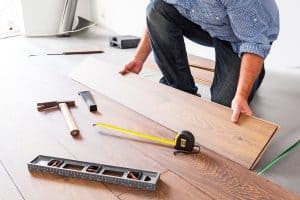6 Things To Look For In Choosing The Right Rental Property Flooring

By Lillian Connors
Choosing the best flooring for your rental property differs greatly from going with your personal preferences. It’s very different from furnishing your own home.
Rental spaces face a lot more wear and tear. Many tenants don’t take care of the flooring as the owner would. In addition, you’ve invested in the rental to make money. The choice of the floor should follow the line. In short, an ideal rental flooring needs to be affordable, durable, and low-maintenance. Too it must be easy to install and aesthetically pleasing. Let’s review the options.
No. 1 – Affordability
The cost of a new floor depends on three factors. These are the cost of material, the cost of installation, and cost of maintenance. Just like with every kind of product, there are high-end and low-end versions of each type. For the greatest part, the floors that lean toward the affordability end of the scale include tile, cork, wood tile, vinyl sheets, vinyl tile, laminate and linoleum.
No. 2 – Ease of maintenance
A floor that is easy to keep clean and good-looking is the one that doesn’t need regular maintenance, such as waxing, oiling, or buffing. This is an important consideration for a rental property. There are tenants who completely forgo regular maintenance. In addition, maintenance often requires that all furniture is removed from the room, which means the best time to do it is between tenants. This increases your workload at tenant turnovers. As the ease of maintenance is concerned, the list goes like this: engineered hardwood, cork, vinyl sheets, vinyl tile, laminate and linoleum.
No. 3 – Aesthetics
Naturally, your primary goal is to rent your unit easily. So the aesthetic aspect of your floor needs to go hand in hand with the affordability and ease of maintenance. For a more cohesive, upscale look, it’s always recommended to go with the same flooring throughout the unit, except the bathroom and the kitchen. Bathrooms and kitchens require water-resistant flooring. In addition, having the same flooring in the entire apartment helps it look bigger and more up-to-date. On the aesthetics side, the winners are vinyl tile, laminate and linoleum. Let’s look into each option separately.
Three types of flooring for your rental property
No.1 – Vinyl flooring
For many landlords, vinyl is an absolute favorite, not only because it comes in tile, planks or sheets, but also due to the fact that it resembles raw materials. Also, vinyl floors are highly water-resistant, which makes them suitable for kitchens as well. Another bonus is the fact that it doesn’t require prepared subflooring, which makes the installation easier. If you decide to go with contemporary vinyl planks, you’ll be surprised by the amazing range of natural looks of wood, stone and ceramics, now made possible with 3D printing techniques.
No. 2 – Wood laminate flooring
Another affordable option, wood laminate is easy and quick to install. Unlike vinyl, however, it’s best that you apply a tough finish layer to protect the floor from fading, staining or premature wear from traffic. As a cost-effective hardwood alternative, laminate floors are an ideal option for landlords on a budget who believe in the undisputable charm of wood floors.
No. 3 – Linoleum
From its invention in the mid-1800s to the early 1950s, linoleum was among the most popular flooring materials in the world. This naturally sourced material has anti-static properties that prevent dust particles from sticking to its surface, while its anti-microbial properties make it a popular choice for kitchens and kids’ rooms. Although early forms used to be much more brittle, manufacturing processes (along with watertight installation) have made this durable material popular again. On the aesthetic side, its hues and patterns extend down through the wear layer, so there is no risk of fading or discoloring.
Source: rentalhousingjournal.com















 Accessibility
Accessibility